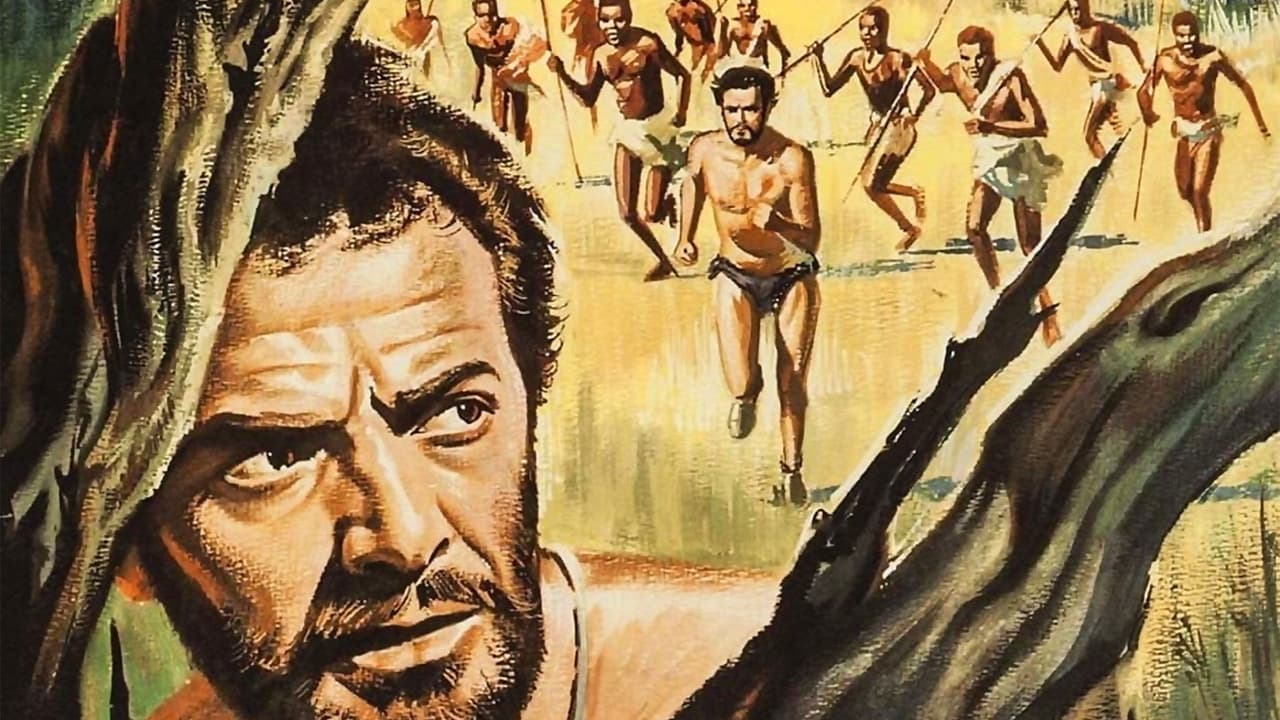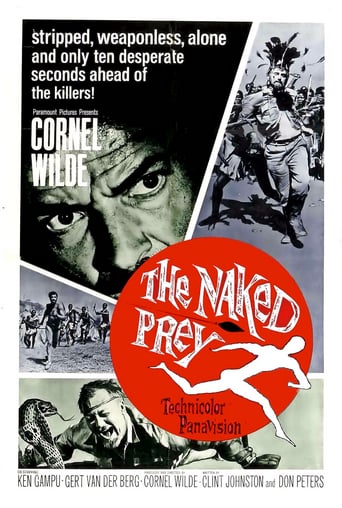

Truly a movie that could not easily be made today. The plot is simple; the man financing an African ivory safari (Gert Van den Bergh) offends a tribe by not paying them a tribute gift against the advice of his own guide (Cornell Wilde). The tribe takes them prisoner back to their village and kills all except Wilde in various imaginative and gruesome ways for the amusement of the tribe. Presumably because he wanted to pay the tribute, Wilde is given a sporting chance; he's stripped naked, and given a head start before several of the men begin to hunt him down and kill him like an animal. The first pursuer misses Wilde with a spear, which Wilde uses to kill that pursuer and take his footwear and some of his equipment. Wilde not only has to elude his pursuers, he has to cope with his own thirst and hunger at the same time. When he kills a deer, a lion steals it from him. Throughout the movie there are scenes of animals pursuing and killing each other. One animal scene even mirrors the plot when a baboon being stalked by a cheetah survives by being willing to fight back. Even the plant life is shown as being inhospitable to being eaten. There are a few plot holes; early in the movie the financier of the safari mentions to Wilde that next time he'd like to combine hunting for ivory with the slave trade. This is inconsistent with the times (around 1850) since by then, the slave trade but not slavery itself had come to an end. The village where the safari party is taken to is filled with thin people except for the village chief, who is enormously fat, like Jabba the Hut. How'd a guy like that get to be chief? It probably takes half the village resources to maintain his fatness. The head pursuer (Ken Campu) was a tall, fit looking guy who looked like he could have easily killed the chief and taken over the village. The other plot hole occurs when Wilde starts a fire in order to drive his pursuers away when they were at most a minute behind him. Where did he get the materials to start a fire so quickly? Did one of the pursuers he killed have firestarting materials? Those plot holes aside, the movie was beautifully photographed and well acted by all. The Africans were not stereotypical villains; they showed true sorrow and caring when one of them was killed or injured. They were not superhuman; they also need to catch their breath, eat and drink. Spoiler alert! Don't read any further if you haven't seen the movie! At the end, when Wilde's character is about to be rescued, he turns and salutes the head pursuer, who returns the salute. There is a similar scene in "Jeremiah Johnson" when an indian who's tribe has been relentlessly pursuing Johnson gives him a similar salute as if to say "I'm calling an end to the pursuit". Unlike many movies today, you cannot add a disclaimer saying that "no animals were harmed in the making of this movie". Many animals were indeed harmed, from a small toad or frog being eaten by a larger one to several elephants being shot and disemboweled.My criticisms? I'd have liked some subtitles so I could've have known what the pursuers were saying. For example, early in the chase, it appears like the head pursuer was ordering some of his men to go this way and others to go that way. Was he unsure which way Wilde had gone, or was he trying to trap Wilde between two groups of pursuers? Toward the end of the movie, Wilde befriends a young girl who's village was destroyed by slave traders. After walking with Wilde for a while and sharing songs, she decides she wants to go back. Go back to what? Her village was burned and most everyone was taken as slaves or killed outright! Even Wilde shakes his head and murmurs "I hope you'll be all right," but he doesn't try and stop her. Previous reviewers have found racism in this movie because some of the Africans are portrayed as vicious savages taking pleasure in gruesome killing. Why should Africans be portrayed any different from Europeans? The history of all humans is filled with examples of cruelty as entertainment, regardless of race. Besides, tribal and religious warfare with appalling cruelty still goes on in Africa. Reviewers have also found it strange that a white man out of his element is able to survive and in some cases turn the tables on some of his African pursuers. In this movie, the white man is not out of his element. He's a professional safari guide. Any north woods hunting guide is probably fitter and more skilled at survival than local hunters. Speaking of fitness, Cornell Wilde looks in great shape for a man of 53. I can only think of a few Hollywood actors who could have met the physical qualifications of this role in their 50s.
... View MoreIf you ask me - This 1966 "man-as-the-hunted" picture certainly could have been a helluva lot better. It really could have.It also could have been a helluva lot shorter, too. (Like, by about 30 minutes, I'd say) And it also could have used some subtitles, because almost no English was spoken since most of the characters ended up being African tribesmen who spoke their own lingo.Set in the wilds of Africa in the 1800s, Naked Prey not only starred Cornel Wilde as the story's principal character, but it was also directed by him, as well.Yes. I will admit that Naked Prey was very well-photographed (the many shots of African wildlife were excellent), but, with that aside, its story was just a little too predictable to hold this viewer's undivided attention for its 96-minute running time.Naked Prey's biggest problem (which rendered its story far from being believable) was that Wilde's character was just a little too resourceful for a white man who was stuck in the life-or-death predicament that he was.As a result of his apparent cunning he was able to repeatedly beat and out-fox all of the highly-skilled natives of jungle-land who were in hot and heavy pursuit of him. And even though he was being constantly trailed for a week, non-stop, he managed to survive with almost no food at all.
... View MoreIt's an enjoyable adventure movie because of it contains action , sensational outdoors and outlandish exciting situations abound . It deals with a group of men are on safari , one of the party refuses to give a gift to a tribe they encounter . The tribe is offended and it takes a disastrous turn and our starring (Cornel Wilde who was ill through much of the shooting and evacuated to a hospital for treatment but he followed) winds up unarmed and nude . As African natives (Ken Gampu as Leader of the warriors) give prisoner headstart before they close in on him for pursue . Stripped, turned loose like a wild beast , being relentlessly chased by a violent group who keeps on his heels . There takes place a deadly hunt of man versus nature and man versus man .A tour-de-force adventure drama that brought Cornel Wilde real acclaim as a filmmaker . This is a moving manhunt of indescribable terror and screaming suspense . It is remarkable as well as competently made and it packs strong fights , spectacular sequences and remarkable brutal images ; creating a large impact on Italian sub-genre : ¨Mondo Cannibale¨. Good acting by Cornel Wilde as safari leader pursued by a large bunch of native warriors determined to finish him off . Cornel Wilde was careful to try to avoid harm to animals appearing in the film where possible. In the scene where the python and the monitor lizard battle, it became clear that the python was winning and the monitor was in danger ; Wilde personally intervened to save the monitor lizard; the lizard bit him on the leg, refusing to let go. We are seeing several African animals though some of them turn out to be taken from prior stock-shots . The script was originally a true historical incident about a trapper named John Colter being pursued by Blackfoot Indians in Wyoming, but lower shooting costs, tax breaks and material and logistical assistance offered by South Africa convinced Cornel Wilde and the other producers to shoot the film there . Colorful as well as evocative cinematography in Panavisión by R. Thomson . Appropriate musical score by means of drummers and African sounds . This harrowing motion picture was compellingly starred , written , produced and directed by Cornel Wilde . Wilde does a competent job both as actor and filmmaker . I's amazingly well done movie , being Cornel Wilde's best film . He is especially credited as a good actor but also known for directing some acceptable flicks . His later films were of varying quality, and he ended his career in near-cameos in minor adventure films . As he directed adventures as ¨Maracaibo¨ ,¨Lancelot and Guinevere¨, ¨Sharks' Treasure¨ but also Noir Cinema as ¨The Devil's Hairpin¨, ¨Storm Fear¨ and Sci Fi : ¨Blade of Grass¨. ¨The naked prey¨ rating : Notable , well worth watching . Essential and indispensable seeing for adventure/action fans . It's a good stuff for young people and exotic adventures lovers who enjoy enormously with the extraordinary danger in the lush jungle.
... View MoreWhat an amazing film , the use of the cinematography and the landscapes, the acting and a commendable plot make this a must see .I also admired the way the director used animal hunter and prey film alongside what is happening to the protagonist of the piece.Oddest thing is that my mum remembered the 'baking' scene and it has stayed with her all this time she saw it on British T.V 38 years ago !! I too thought this to be quite grueling for the films vintage and the fact it was released from one of the major mainstream distributors makes it surprising too.The new DVD release has done this complete justice but would one expect anything less from the 'Rolls Royce' of DVD distributors. I read on here a comment about the exorbitant price tag but would comment that it deserves it.So much care has been taken using the best print and the most complete version possible. There is also a fascinating commentary to listen too if you have the time and other worthwhile extras.This I feel has 'forgotten classic' invisibly etched on every frame.A must see and must have.
... View More